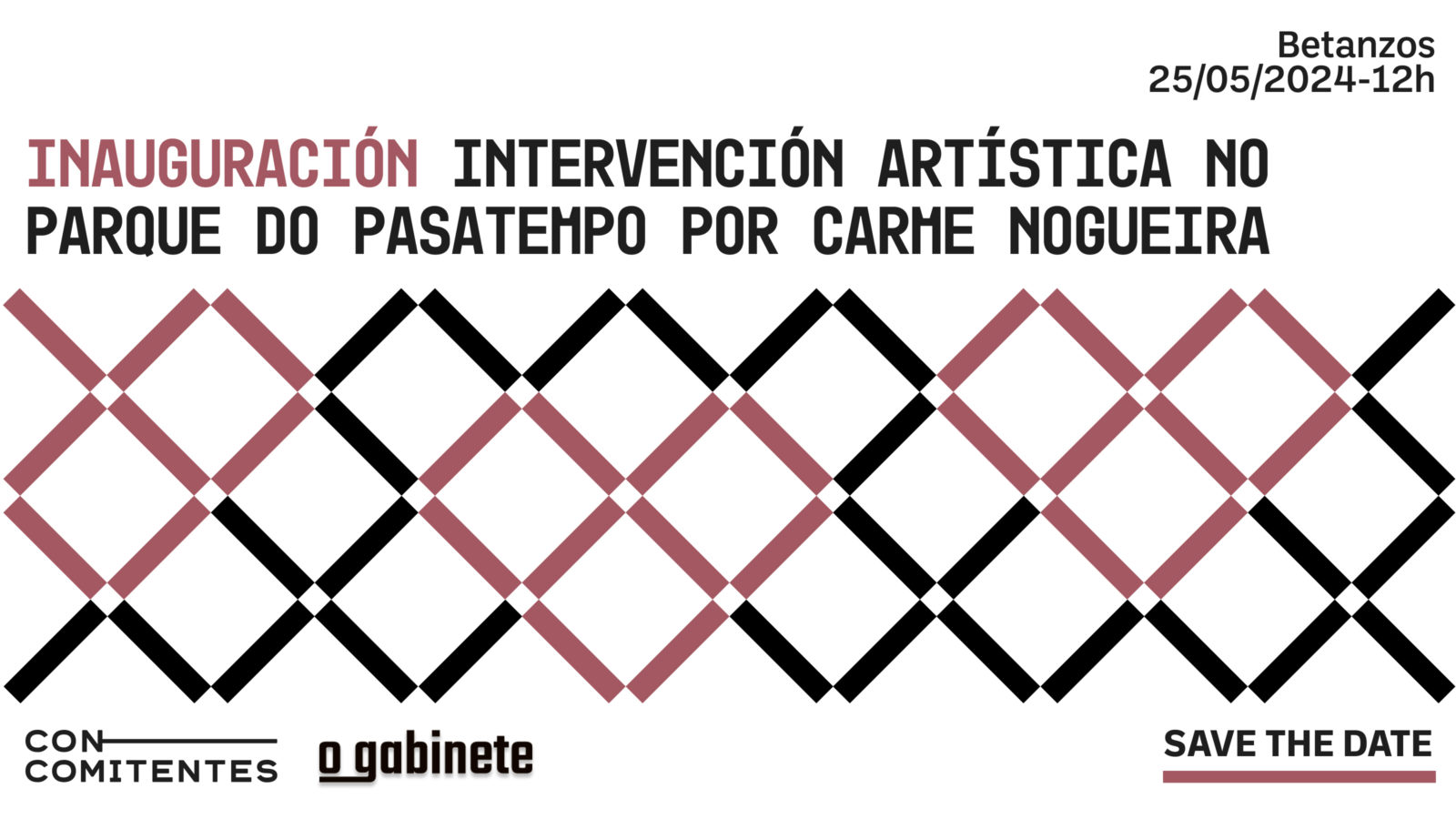The artistic intervention of Carme Nogueira will be inaugurated on 25th May in the Parque do Pasatempo in Betanzos.

Date 25/05/2024
Place Parque do Pasatempo (near the statue of Charity)
Address Av. de Fraga Iribarne, 3, 15319 Betanzos, A Coruña
Timetable 12:00-14:00hrs
The installation, made up of seven pieces of recycled cement and a landscape intervention by Iñigo Segurola in the vicinity of the Parque do Pasatempo, seeks to create a new meeting space.
To read the news in English click here.
The project ‘Coidado Legacy’ iniciou a súa andaina en 2018, da man do mediador Fran Quiroga and the citizens of Betanzos, with the aim of reflecting, through an artistic-participative process, on the care of the historical legacy of the Irmáns García Naveira in this Galician town.
As a result of this journey, the Galician artist Carme Nogueira created an artistic intervention in the Parque do Pasatempo that will be inaugurated publicly next Saturday, 25th of May at 12h. In addition, the surroundings where the work will be installed have been transformed and intervened with a landscape proposal by Iñigo Segurola.
A canle da antiga canle as inspiration
The artistic intervention, which will consist of seven modular pieces of recycled cement measuring 150x100x 67cm based on a fictitious creation of the Fountain of Neptune, will take place in the immediate vicinity of the statue of Charity. The objective, beyond the work itself, is to transform this space so that it becomes a place of coexistence for the neighbours. Thus, the pieces will be able to be used as benches, stairs, tables... and other uses that accompany the collective needs of this reimagined place.
The artistic inspiration for this work, in Carme's own words, was the presence of “water” as a skeleton that supports both the visual and sculptural realities of the place. The disappearance of the canal that used to run through the park today interrupts the reading of the sculptural and landscape ensemble, and this absence also gives way to imagination, to generate other horizons that respond to a collective expectation.

In addition to the production of these artistic pieces, there will also be a landscape intervention by the landscape designer Iñigo Segurola. His proposal focuses on recreating the canle as much as possible and accompanying this intervention with a dense plantation of exotic character. A plantation that will act as a screen facing the pitch and the advertising values of the current football pitch, creating a sophisticated backdrop, rich in textures and visual contrasts, which is designed to emulate a semi-tropical intervention that recovers the collecting spirit implicit in the origins of the Parque do Pasatempo. Among other natural elements, the proposal includes the planting of four sequoias, four false coconut trees or 29 Japanese banana trees, among others.
The project also had the technical assistance of the architect Carmen Calatayud, the architecture professor of the University of A Coruña José Manuel Vázquez Mosquera and the archaeological team Arbore, as well as the production of the company ARCE for the garden.
The artistic work takes place in an area declared of Cultural Interest (BIC), the highest figure of heritage protection in Spain. This work will be a new heritage resource for Betanzos, enriching the already rich cultural heritage of the town. This work is the result of the invaluable support of the Daniel and Nina Carasso Foundation, as well as the Council of Betanzos, the Deputation of A Coruña, the Xunta de Galicia and the Government of Spain through the Spanish Presidency of the Council of the European Union. We also collaborated with the Asociación Amigas do Parque do Pasatiempo, ACLP Roxin Roxal and the Asociación Amigos del Casco Histórico de Betanzos.

Artistic and landscape combination
Carme Nogueira (Vigo, 1970) holds a degree in Fine Arts from the University of Salamanca and a PhD from the University of Vigo. In her artistic career she has worked from body criticism to the concept of identity or domestic intimacy with respect to her gender position. She is currently working on the processes of subjectivation and the normalising function of spaces through photography and installation. His work is part of several Spanish museums, such as the Reina Sofía, MUSAC and CGAC.
On his side, Iñigo Segurola was in charge of the gardening section of the famous Bricomanía programme and since 1994 he has been co-owner of Lur Paisajistak. Nowadays he is still developing projects as a landscape gardener, but he is focused on his life's project, Lur Garden.
The project ‘Legado Cuidado’ (Legacy Care) began in 2018, with the help of the mediator Fran Quiroga and the neighbours of Betanzos, with the aim of reflecting, through an artistic-participative process, on the care of the historical legacy of the García Naveira brothers in this Galician town.
As a result of this journey, the Galician artist Carme Nogueira has created an artistic intervention in the Parque do Pasatiempo which will be publicly inaugurated on next Saturday, 25th May at 12h. In addition, the surroundings where the work will be installed have been transformed and intervened with a landscape proposal by Iñigo Segurola.
The old canal bed as inspiration
The artistic intervention, which will be made up of seven 150x100x 67cm modular pieces of recycled cement based on a fictitious cutting up of the Fountain of Neptune, will be made in the vicinity of the Statue of Charity. The aim, beyond the work itself, is to transform this space into a place of conviviality for local residents. Thus, the pieces can be used as benches, stairs, tables... and other uses that accompany the collective needs of this reimagined place.
The artistic inspiration for this work, in Carme's own words, was the presence of “water” as a skeleton that supports both the plant and sculptural realities of the place. The disappearance of the canal that used to run through the park today interrupts the reading of the sculptural and landscape ensemble, and this absence also gives way to the imagination, to generate other horizons that respond to a collective expectation.
In addition to the production of these artistic pieces, there will also be a landscape intervention by the landscape designer Iñigo Segurola. His proposal focuses on recreating the canal as far as possible and accompanying this intervention with a dense planting of an exotic nature. A plantation that will act as a screen towards the enclosure and advertising hoardings of the current football pitch, generating a sophisticated backdrop, rich in textures and plant contrasts, which is projected to emulate a semi-tropical intervention that recovers the collecting spirit implicit in the origins of the Parque do Pasatempo. Among other natural elements, the proposal includes the planting of four sequoias, four false coconut trees and 29 Japanese banana trees, among others.
The project has also benefited from the technical assistance of architect Carmen Calatayud, architecture professor at the University of A Coruña José Manuel Vázquez Mosquera and the Arbore archaeology team, as well as the production of the ARCE company for the garden.
The artistic work takes place in an area declared of Cultural Interest (BIC), the highest figure of heritage protection in Spain. This work will represent a new heritage resource for Betanzos, enriching the already rich cultural heritage of the town. This work is the result of the invaluable support of the Daniel and Nina Carasso Foundation, as well as the Town Council of Betanzos, the Provincial Council of A Coruña, the Xunta de Galicia and the Government of Spain through the Spanish Presidency of the Council of the European Union. It has also collaborated with the Asociación Amigas del Parque del Pasatiempo, ACLP Roxin Roxal and the Asociación Amigos del Casco Histórico de Betanzos.
Artistic and landscape combination
Carme Nogueira (Vigo, 1970) holds a degree in Fine Arts from the University of Salamanca and a PhD from the University of Vigo. In her artistic career she has worked from corporal criticism to the concept of identity or domestic intimacy with respect to her gender position. She is currently working on the processes of subjectivation and the normalising function of spaces through photography and installation. Her work forms part of several Spanish museums, such as the Reina Sofía, the MUSAC and the CGAC, and her latest projects include: ‘Vida Hurdana. Lo que escriben los niños’ presented at the Lalín Biennial (2017), ‘El Contrato’, Bilbao 2014; among others.
Iñigo Segurola was in charge of the gardening section of the famous Bricomanía programme and since 1994 he has been co-owner of Lur Paisajistak. Today he continues to develop projects as a landscape gardener, focusing on the project of his life, Lur Garden.










 Concomitentes
Concomitentes